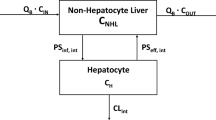Abstract
Plasma disopyramide concentration-time data and plasma protein binding measurements were obtained in 12 patients requiring disopyramide for suppression of their cardiac arrhythmias. The fraction of disopyramide unbound to plasma proteins varies from approximately 0.19 to 0.46 over the therapeutic range of total plasma concentrations (2–8 mg/liter). Data from single and multiple intravenous doses were analyzed using two models based on the hypothesis either that clearance is independent of the total disopyramide plasma concentration (total clearance model) or that clearance is independent of the concentration of disopyramide unbound to plasma proteins (free clearance model). This analysis indicates that only the free clearance model satisfactorily describes the data as a linear system. Using the free clearance model and data obtained from single doses, multiple intravenous infusions were designed for each patient which would rapidly attain and maintain predetermined plasma disopyramide concentrations. The calculated and observed disopyramide concentrations were in close agreement. In the 12 patients studied, at any given total disopyramide plasma concentration, there was an approximately twofold range in the fraction of disopyramide unbound to plasma proteins. Mean plasma protein binding data are therefore of little value in a given patient for predicting free disopyramide concentrations from measurements of total disopyramide concentration. Difficulties in the clinical management of patients receiving disopyramide, resulting from the nonlinear disposition of the usually measured total disopyramide concentrations, are discussed.
Similar content being viewed by others
References
R. E. Ranney, R. R. Dean, A. Karim, and F. Radzialowski. Disopyramide phosphate: Pharmacokinetic and pharmacologic relationships of a new antiarrhythmic agent.Arch. Int. Pharmacodyn. Ther. 191:162–188 (1971).
A. Karim. The pharmacokinetics of norpace.Angiology 26:85–98 (Suppl. 1, Part 2) (1975).
J. W. Ward and S. R. Kinghorn. The pharmacokinetics of disopyramide following myocardial infarction with special reference to oral and intravenous dose regimens.J. Int. Med. Res. 4:49–53 (Suppl. 1) (1976).
R. E. Rangno, W. Warica, R. I. Ogilvie, and E. Bridges. Correlation of disopyramide pharmacokinetics with efficacy in ventricular tachyarrhythmia.J. Int. Med. Res. 4:54–58 (Suppl. 1) (1976).
J. Hulting and S. Rosenhamer. Antiarrhythmic and haemodynamic effects of intravenous and oral disopyramide in patients with ventricular arrhythmias.J. Int. Med. Res. 4:90–95 (Suppl. 1) (1976).
J. DeGraeve, P. Kremers, and J. E. Sielen. Etude pharmacocinetique et metabolique comparative de la disopyramide administree par voie orale et intraveineuse.Therapie 32:195–204 (1977).
P. H. Hinderling and E. R. Garrett. Pharmacokinetics of the antiarrhythmic disopyramide in healthy humans.J. Pharmacokin. Biopharm. 4:199–230 (1976).
J. L. Cunningham, D. D. Shen, I. Shudo, and D. L. Azarnoff. The effects of urinepH and plasma protein binding on the renal clearance of disopyramide.Clin. Pharmacokin. 2:373–383 (1977).
P. J. Meffin, S. R. Harapat, and D. C. Harrison. High-pressure liquid Chromatographic analysis of drugs in biological fluids. III. Analysis of disopyramide and its non-N-dealkylated metabolite in plasma and urine.J. Chromatog. 132:503–510 (1977).
J. G. Wagner. A safe method for rapidly achieving plasma concentration plateaus.Clin. Pharmacol. Ther. 16:691–700 (1974).
J. G. Wagner. Linear pharmacokinetic equations attaining direct calculation of many needed pharmacokinetic parameters from the coefficients and exponents of polyexponential equations which have been fitted to the data.J. Pharmacokin. Biopharm. 4:443–66 (1976).
S. Knott and D. Reece. Model Lab Users Documentation, Division of Computer Research Technology Report, National Institutes of Health, Bethesda, Md. September (1971).
H. Boxenbaum, S. Riegelman, and R. Elashoff. Statistical estimations in pharmacokinetics.J. Pharmacokin. Biopharm. 2:123–148 (1974).
B. B. Brodie, E. W. Lowman, J. J. Burns, P. R. Lee, T. Chenkin, A. Goldman, M. Weiner, and J. M. Steele. Observations on the antirheumatic and physiologic effects of phenyl-butazone (butazolidin) and some comparisons with cortisone.Am. J. Med. 16:181–190 (1954).
R. Runkel, E. Forchielli, H. Sevelius, M. Chaplin, E. Segre. Nonlinear plasma level response to high doses of naproxen.Clin. Pharmacol. Ther. 15:261–266 (1974).
G. T. Tucker, R. N. Boyes, P. O. Bridenbaugh, and D. C. Moore. Binding of amide-type local anesthetics in human plasma. I. Relationships between binding, physicochemical properties and anesthetic activity.Anesthesiology 32:287–303 (1970).
J. Koch-Weser and E. M. Sellers. Binding of drugs to serum albumin.New Engl. J. Med. 294:311–316 (1976).
D. C. Harrison, P. J. Meffin, and R. A. Winkle. Clinical pharmacokinetics of antiarrhythmic drugs.Prog. Cardiovasc. Dis. 20:217–242 (1977).
Author information
Authors and Affiliations
Additional information
This work was supported in part by NIH Grants Nos. 1-RO1-HL-21221 and RR-70, and by Searle Laboratories, Skokie, Illinois. Dr. Winkle is the recipient of a Mellon Foundation Fellowship.
Rights and permissions
About this article
Cite this article
Meffin, P.J., Robert, E.W., Winkle, R.A. et al. Role of concentration-dependent plasma protein binding in disopyramide disposition. Journal of Pharmacokinetics and Biopharmaceutics 7, 29–46 (1979). https://doi.org/10.1007/BF01059439
Received:
Revised:
Published:
Issue Date:
DOI: https://doi.org/10.1007/BF01059439




